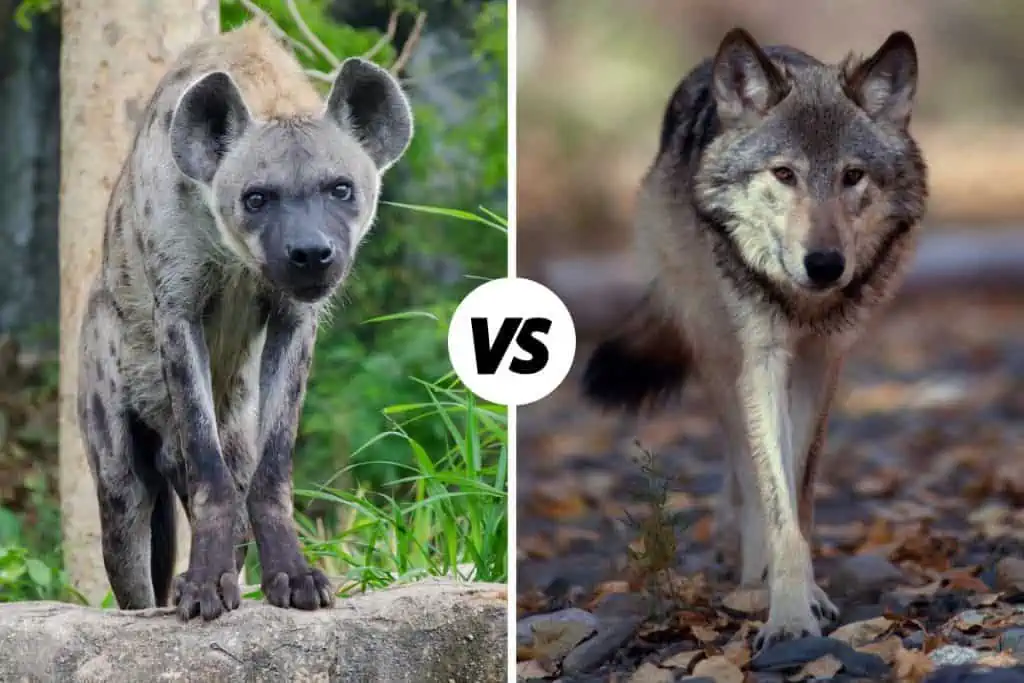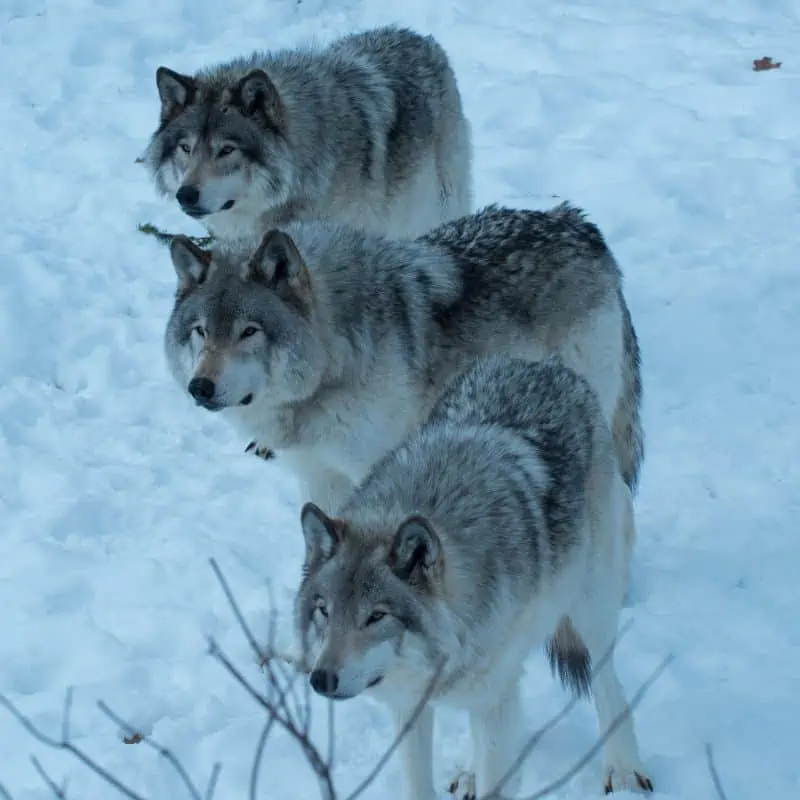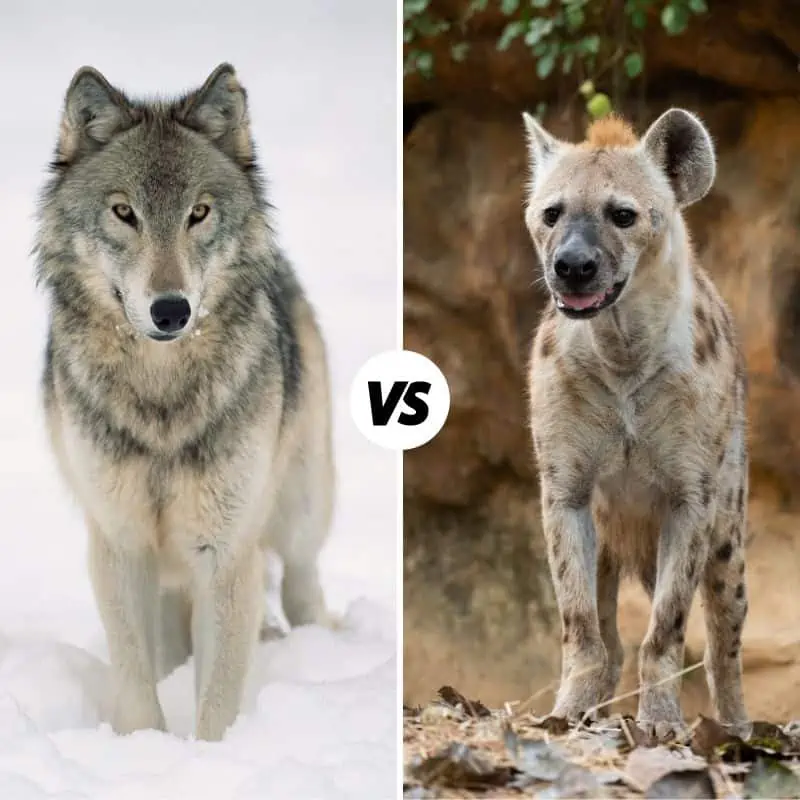The hyena and the wolf are two apex predators that occupy different niches in the food chain. With their similar characteristics, it can be difficult to tell apart these two members of the Canidae family. Both have strong jaws, sharp teeth, and a lean build. But what are some key differences between a hyena and a wolf?
Wolves and hyenas differ in habitat, size, body shape, hunting style, and diet. Wolves tend to be larger with longer legs, living in colder climates and hunting in packs. Conversely, hyenas are found in dryer regions, hunt alone or in small groups using their powerful jaws and sharp teeth to take down animals, and primarily eat carrion or decaying matter.
There are many differences between a wolf and a hyena that make them unique species. Understanding the characteristics of these two animals can help us appreciate their diversity and value in the natural world. So Keep reading.

Main Differences Between Hyenas And Wolves
The hyena and the wolf are two of the world’s most iconic predators. They have a great deal in common, as both are successful hunters that live in packs and feed on similar prey.
However, there are also distinct differences between these two species that set them apart.
Let’s explore the key differences between hyenas and wolves.
Physical Characteristics
The wolf is a large, powerful canine with pointed ears, yellow eyes, and a long bushy tail. It typically grows to 36 to 63 inches and can weigh up to 40 to 175 pounds.
Its body is robust and covered with fur, providing insulation against the cold. Its coat is mostly gray but can vary from white to brown to black.
The paws of a wolf are large and clawed, enabling it to hunt down its prey effectively.
These physical features, combined with its highly developed senses, make it one of the most feared predators in nature.
The hyena is a medium-sized animal with a muscular body, short legs, and long curved claws used for digging.
The most common hyena species typically grows to 1.6 m long and can weigh up to 86 kg.
Hyenas have relatively short muzzles, small ears, and bushy tails. The fur color of the hyena can vary from light brown to blackish-brown, depending on the species.
Hyenas have powerful jaws and sharp teeth adapted for hunting and scavenging. These features make them well-suited for their omnivorous
Social Structures
The wolf is a highly social animal that lives in packs of 6 to 10 members. Each pack has a hierarchical structure with an alpha pair at the top and subordinate members below them.
Wolves communicate using body language and calls, with each member having distinct vocalizations.
Howlings are used to signal the location of the pack, while growling and barking are used for warning.
A group of hyenas is known as a clan, pack, or cackle. This phrase applies mainly to the spotted hyena and its two varieties, the brown and striped types. The aardwolf often lives alone.
Clan membership can vary from two to 80 individuals, usually comprising related females with their young plus some unrelated males. Inside the pack, social order is regimented, with the alpha female at the top.
Hyenas also communicate with one another through scent marking, which allows them to keep track of their territory and alert the clan to danger.

Reproduction and Life Spans of Wolves
Wolves are social animals living in packs consisting of 6 to 10 members. They reproduce annually; depending on the size of the pack, there may be several litters each year (usually between 4 and 6 pups).
Wolves are polygamous and the alpha pair of pack mates for life. The gestation period is 63 days, and pups are born in dens away from their main living area.
Pups stay with their parents for up to two years, learning survival skills before leaving the pack and finding their territories.
The lifespan of a wolf is typically 6 to 8 years in the wild. In captivity, wolves may live up to 17 years.
The gestation period of hyenas is between 89 and 111 days.
At birth, the cubs feed on their mother’s milk, and they will remain dependent on their mother for the first few months of life.
In the wild, hyenas typically give birth in a den or burrow, and the mother will care for her cubs until they are independent, around two years of age.
The lifespan of a hyena in the wild is typically around 12 years and can extend beyond 25 years in captivity.
Habitats And Hunting Strategies
Hyenas are opportunistic animals that inhabit various habitats, such as deserts and grasslands. They hunt using powerful jaws or in packs/solitary and rely on their sharp sense of smell to locate food sources.
They also hunt live animals, such as antelopes and wildebeest. Hyenas have adapted well to harsh conditions, allowing them to thrive despite challenges like habitat destruction.
Wolves are highly adaptive and inhabit various habitats, such as forests, grasslands, mountains, and tundra.
In the US, they can be found in Alaska, Canada, and many other states. Wolves tailor their hunting strategies depending on the environment and prey available.
In open areas, they hunt together in packs to take down large animals like elk and deer, whereas, in dense forests, they hunt alone or in small groups to flush out smaller creatures.
Wolves use their powerful senses of smell and hearing to spot prey before ambushing them, enabling them to thrive in a range of ecosystems.
Threats And Conservation Status
Both wolves and hyenas are classified as vulnerable species and face the threat of extinction due to human activity. Wolves are exposed to poaching, habitat destruction, and retaliatory killings from livestock owners.
Hyenas also from habitat loss due to urbanization and land degradation caused by humans. They are also hunted for their fur, bones, and meat.
To protect and conserve these species, various conservation initiatives have been undertaken by independent organizations and governments.
These include active monitoring and protection of their habitats, support for local communities that coexist with these species, and educational efforts to raise public awareness about their importance in the environment.
Furthermore, captive breeding programs are being conducted to ensure the survival of these species.

Final Thoughts On Hyena Vs Wolf Differences
Hyenas and wolves are two fascinating species with unique adaptations to their respective environments.
Hyenas are highly opportunistic animals that inhabit various habitats and hunt in packs or alone, whereas wolves live and hunt primarily in packs, relying on strong senses of smell and hearing to locate prey.
Both species face threats from human activity and require conservation efforts to protect them from extinction.
It is our responsibility to ensure the preservation of these species for future generations by actively supporting their conservation and protecting their habitats.
With this in mind, we can help to guarantee the survival of both hyenas and wolves for many generations to come.
